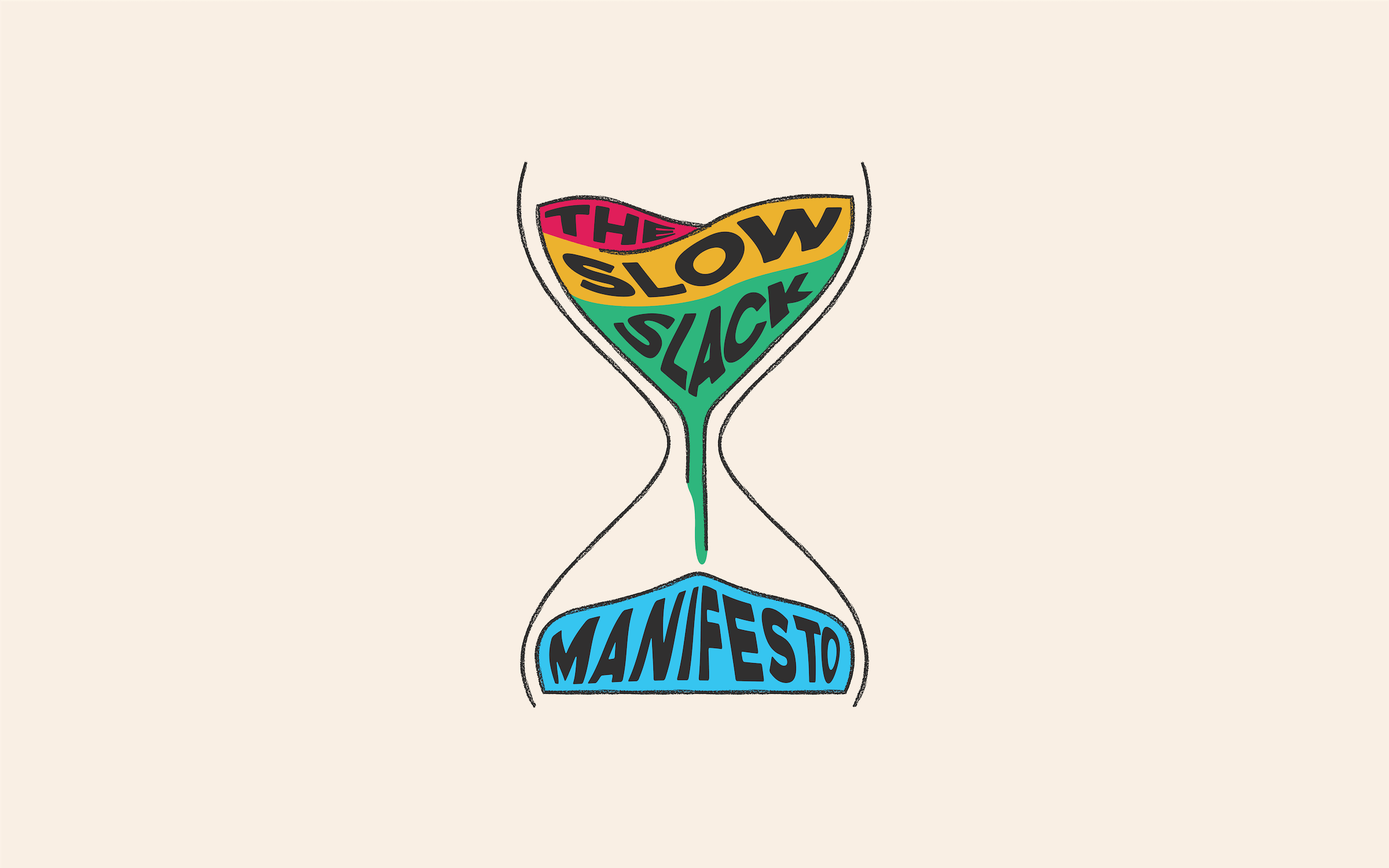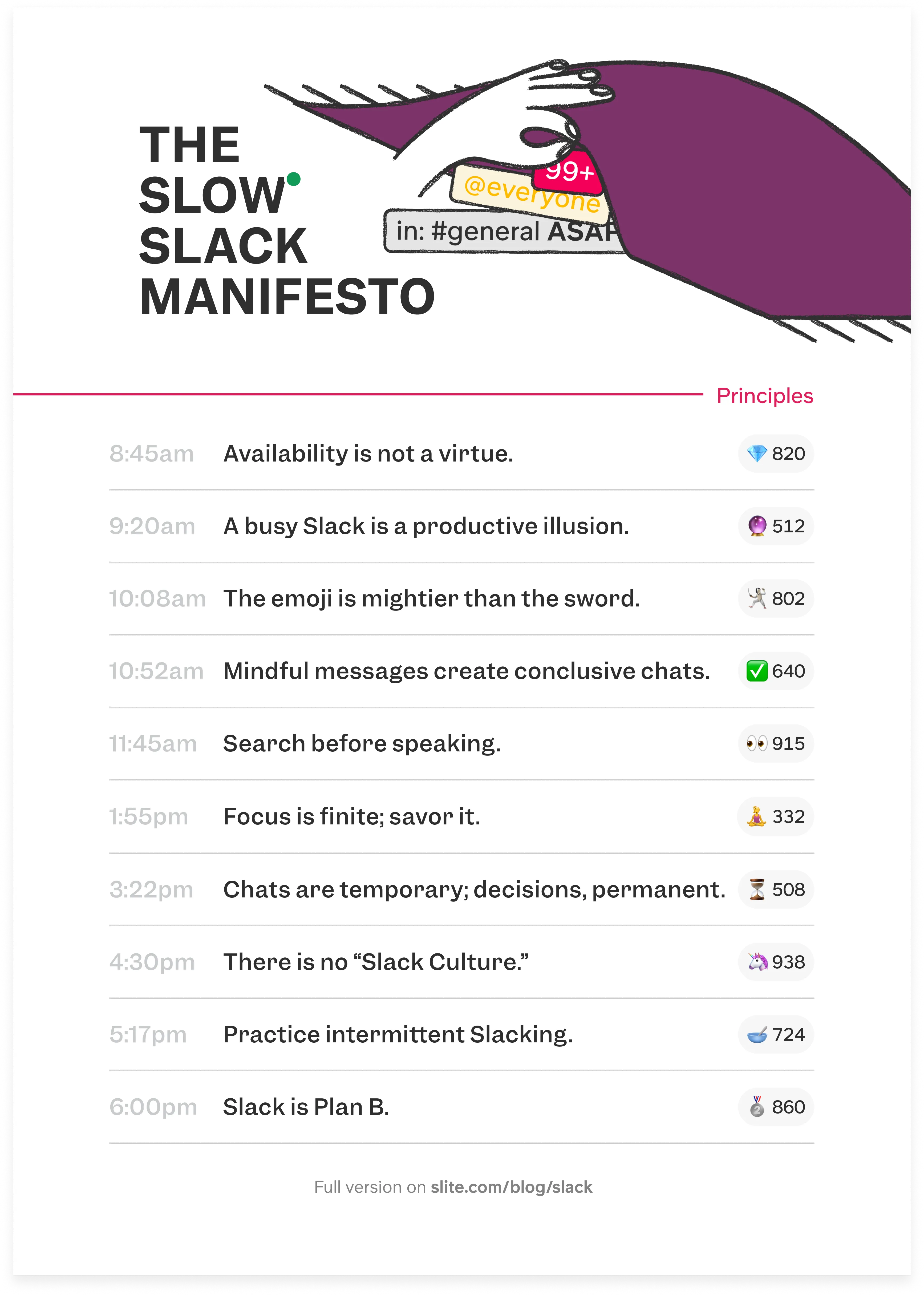The slow Slack manifesto

Slack has become synonymous with chat; it even has its own verb in the startup lexicon (Can you slack me that snackable content by EOD please?). In many organizations Slack has replaced email; at remote companies it's replaced the watercooler; and its recent acquisition by Salesforce cements its status - Slack is here to stay.
You may not get to choose whether Slack is part of your life, but you can control its effect on your focus. Slack is engaging and instantaneous, but it doesn't have to take all of your attention, or interrupt your flow. That's why we wrote this manifesto - it's a set of beliefs to guide you towards more intentional, async communication.
Slow Slack will help you clarify your messages, save time, and still bond with your colleagues over vacation photos and memes. So without further ado, our 10 principles for slowing down Slack.
1. Availability is not a virtue
Deep work? Then you're not available. Don't let a little green dot control the flow of your neurons. Presence means you're reachable. Don't be reachable. Set your status as unavailable.
2. A busy Slack is a productive illusion
Pings and zaps from bots and apps create noise. Turn down the volume by leaving and deleting inactive channels, disabling unnecessary bots (except those for bugs, downtime, and other emergencies) and curating apps that spark joy and encourage flow.
3. The emoji is mightier than the sword
Want to send "yes" or "no" or "awesome"? Don't. Use an emoji reaction. No red dot notification, no bolded unread channel. Message relayed.
4. Mindful messages create conclusive chats
When we mindlessly chat our colleagues, we leave out valuable context. Always include the reason you're asking for someone's time and attention. Hey Ben, did you finish the landing page? vs. Hey Ben, did you finish the landing page because I'm off to Swaziland tomorrow and the ads are running already.
5. Search before speaking
Go on, take your time. Search for something before asking someone else. If a conversation is happening somewhere, don't start a new one elsewhere. Look for a document before creating a new one. Don't turn your workplace into conversation stew.
6. Focus is finite; savor it
The "Golden Rule" of Slack. Focus is finite. When you use @here @channel, consider whether the information you're about to share is truly relevant to everyone. Not only will you save precious focus, but you'll also improve trust.
7. Chats are temporary; decisions are permanent
There's a difference between an agreement and a decision. One is solely communication; the other implies action. Slack is for agreements, not decisions. Agreed? Good.
8. There is no "Slack Culture"
Just because others use Slack a certain way doesn't mean it works for your role or tasks. Mindfulness + intention = a happier Slacker. Create your own Slack user manual and update it as time goes on, to maximize happiness and make the tool work for you.
9. Practice intermittent Slacking
Just like we shouldn't check our phone first thing in the morning, we shouldn't be married to Slack. Check it when you log in, catch up midday, and go through it when you log off. Look at you, you're being more productive already.
10. Slack is Plan B
Designers work in design tools; engineers work in text editors. Until a company creates the role of social butterfly, Slack is not the number one place where work gets done. Use the right tool for the job, and make Slack your second option, in case you need it.
ASMR Version
To get you in the focus state of mind.
For taping to your office/coworking space/closet wall.
Download The Slow Slack poster →


Written by Melanie Broder
Melanie Broder is on the Marketing team at Slite, where she works on all things content. She helps Slite users gain new skills through guides, templates, and videos. She lives in New York City, where she likes to read novels and run loops around Central Park.


